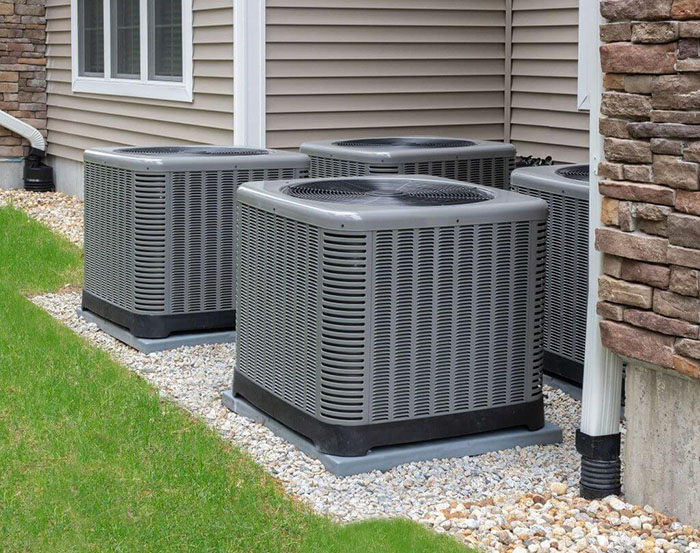How To Determine The Size Of AC Unit Needed Arizona
The proper size of an air conditioning unit is essential to ensure effective cooling in a building and optimal energy efficiency. In Arizona, where temperatures can often reach extreme highs, the need for efficient central air conditioning units cannot be overstated.
This article will discuss how to determine the size of the air conditioning unit needed in Arizona, taking into account factors such as climate and building structure. It will provide guidance on selecting the right size that best meets one’s needs while offering tips on installation and maintenance.
Finally, it will also provide useful information about available models with varying features and prices. With this knowledge, readers should be able to find an ideal AC unit suited to their needs and budget.

Factors To Consider Before Buying An Ac Unit
When selecting an air conditioning unit, there are a few factors to consider. The size of the space that needs cooling is the most important factor in determining what type and size of AC unit to buy. A larger room requires more powerful, higher capacity units while smaller spaces require lower power, smaller sized units.
Additionally, it’s important to consider climate conditions when buying an AC unit. In hot climates like Arizona, higher efficiency models will be needed for optimal comfort levels. It’s also important to think about energy usage as some systems have higher output but also use more electricity than others.
Finally, budget should be taken into account when deciding on an AC unit; prices range from low-cost basic models up to high end ones with all sorts of features and benefits that come at a premium cost.
Estimating The Size Of The Ac Unit
In order to determine the size of an AC unit needed in Arizona, there are several factors that must be taken into account. The climate and temperatures of the area should be considered first, as well as how many people will inhabit the space where the air conditioning system is being installed.
Additionally, the dimensions of the room or building can impact what type and size of unit is necessary for efficient cooling.
The most important factor when choosing a correctly sized AC unit is heat load calculation, which takes into consideration all elements such as insulation level, windows, number of occupants and other factors that affect how much capacity an AC unit needs to have to adequately cool a given area. Heat load calculations also depend on whether one requires heating capabilities from their AC system or not, as this further affects sizing requirements.
Once all these considerations have been made it becomes easier to choose an appropriately-sized AC unit for any space in Arizona.

Calculating The Heat Load
In order to properly determine the size of an air conditioning unit needed in Arizona, it is necessary to calculate the heat load. Heat load is defined as the amount of energy required to keep a space at a comfortable temperature during peak periods. This calculation can be done manually or with software programs that are available online.
Generally, there are two main components taken into consideration when calculating the heat load: internal and external sources of heat. Internal sources include things like lighting, appliances, people and other activities within the space. External sources include solar radiation from outside, wind exposure and humidity.
It is important to note that location also plays a major role in determining how much cooling capacity you need; for example, if your home is located close to desert areas where temperatures tend to spike higher than average during summer months.
Once all these variables have been taken into account, they must then be converted into BTU’s (British Thermal Units) per hour which will indicate the total cooling requirement for your specific area. Armed with this information, one can then use industry standard formulas to choose an appropriate air conditioner system for their needs.
Home Insulation And Window Treatments
In order to determine the size of the air conditioning unit needed for a home in Arizona, it is important to consider factors such as insulation and window treatments. Insulation can help reduce the amount of heat entering the home from outside sources, decreasing cooling cost by up to 15%.
The recommended level of insulation for homes in Arizona is R-30 or higher. Furthermore, it is important that any existing insulation be inspected and updated if necessary. Window treatments should also be taken into consideration when determining the size of the AC unit needed.
Installing blinds, shades, shutters, or curtains on windows can block out sunlight and reduce radiant heat gain during peak summer days. This can reduce energy consumption significantly while maintaining comfortable temperatures indoors. Additionally, ensuring proper sealing around windows will help keep cool air inside and hot air outside. With these two considerations taken into account, homeowners can estimate how large an AC unit they need with greater accuracy.
Local Climate Conditions
The importance of local climate conditions when determining the size of an AC unit for a home in Arizona cannot be overstated. The amount of heat that accumulates within a building is heavily dependent on both outdoor and indoor temperatures.
During the summer months, extreme temperatures are often experienced throughout the state, with some areas exceeding 110°F (43°C). As such, it is important to select an air conditioner capable of efficiently cooling a space while consuming as little energy as possible.
An HVAC contractor can assess a home’s cooling needs by taking into account its insulation level, number of occupants, square footage, and window shading. Additionally, they will analyze average temperature data from around the area to ensure that appropriate sizing calculations are made for the system being installed.
With precise measurements taken into account and up-to-date technology utilized, homeowners can rest assured their air conditioning units will operate effectively during peak usage periods.
Properly Sized Ac Units For Arizona Homes
When choosing an air conditioning unit for a home in Arizona, it is important to consider the size of the space and the climate. The cooling capacity of an AC unit should be based on the square footage of a room or house as well as other factors such as insulation, window area, ceiling height, geographical location, amount of solar exposure, humidity levels and number of occupants.
To determine the proper size AC unit needed for a home in Arizona, one must first measure the total square footage that needs to be cooled. Once this has been determined, they will need to take into account any additional features that can help increase efficiency. This includes adding more insulation or double-paned windows which will reduce heat loss through walls and windows.
Additionally, calculating the climate’s temperature range and local humidity levels are beneficial when selecting an appropriate sized unit so that energy costs remain low while maintaining optimal comfort inside your home. After taking all these considerations into account, homeowners in Arizona can choose from several different sizes of units available to suit their specific requirements.

Professional Consultation And Installation
In order to accurately determine the size of an AC unitneeded for a home in Arizona, it is recommended to consult with a professional. An HVAC technician can provide information on correct sizing and installation requirements. They are knowledgeable about local climate factors that will affect the selection process and help guide decisions based on specific needs.
A professional consultation provides an opportunity to discuss the goals of cooling including energy efficiency, cost effectiveness, and comfort level desired. The contractor should be able to assess existing ductwork, identify any potential problems or areas of improvement, and provide options for equipment upgrades such as air purifiers or humidifiers.
Professional installations ensure proper configuration and safe operation of all components involved, providing homeowners with peace of mind that their system works correctly.







